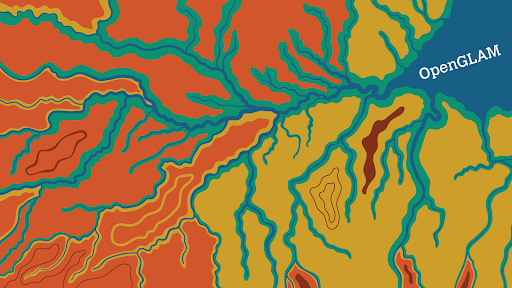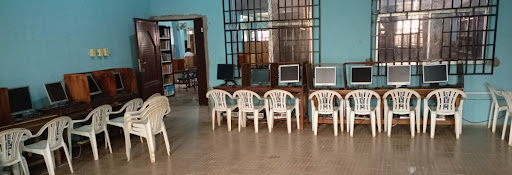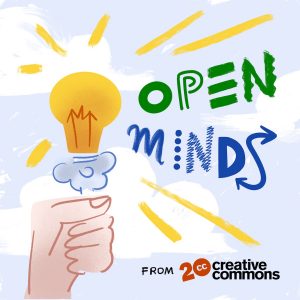Eight case studies show opportunities, challenges, and needs of low-capacity and non-Western cultural heritage institutions
mercredi 4 mai 2022 à 14:54In October 2021, Creative Commons launched a call for case studies on open access in cultural institutions such as galleries, libraries, archives and museums (GLAMs), from low-capacity, non-Western institutions, or representing marginalized,underrepresented communities from various parts of the world.
The aim of the open call was to help generate a more global, inclusive, and equitable picture and understanding of open GLAM, highlighting the needs and expectations of a variety of communities and institutions from diverse regions and backgrounds. Eight successful case studies were selected, and in this blog post, we are pleased to share key highlights from each of them.

Disseminating Open GLAM principles in Brazil (Illustration “Some other lines”, based on the hydrographic network of the Amazon River Basin, by Patrícia Yamamoto, CC BY-NC-ND 4.0)
Commons Voices: contributing life histories to the open knowledge ecosystem in Brazil by Wiki Movimento Brasil
Authors: João Peschanski and Erica Azzellini
This case study focuses on Wiki Movimiento Brazil and Museu da Pessoa, a virtual museum in Brazil that gathers and disseminates oral histories. This unique institution showcases a crowdsourced collection of lives, and the importance and methodological challenges in bringing over 12,000 histories embodying living, intangible community heritage to the open knowledge ecosystem, including challenges related to content licensing. Read the entire case study here.
The state of digital collections within Chilean Public Museums in 2021
Author: Patricia Diaz-Rubio
What is the current situation of Chilean public museums’ digital collections? What are the limits encountered by institutions regarding these collections? These are some of the questions this case study aims to answer. It presents the current status of open access policies and practices in Chilean GLAMs, and how they are used (or not) to promote and disseminate their contents. It also reveals a digital divide between the municipal museums and the museums belonging to the National Direction of Museums from the National Service of Cultural Heritage (SNPC) network, as the former have a minimal online presence and do not have the online environments to disseminate their heritage collections. Read the entire case study here.
Inside the Badagry Slave Heritage Museum in Nigeria: A Case Study

Author: Charles Ikem
This case study transports us to the Badragy Slave Heritage Museum in Nigeria. It analyzes the barriers and challenges to digitizing heritage collections and creating digital spaces for disseminating knowledge about the rich histories and cultures of Africa, as well as the injustice and horror of the transatlantic slave trade. The obstacles are numerous, from copyright limitations to the problem of funding digitization and online access to team opposition based on the misconception of a supposed loss of footfall revenue by allowing users to access the collections online. However, as Charles argues in his case study, making these collections openly accessible could allow for sharing, re-sharing, and building new research on the colonial past and its teaching. Read the entire case study here.
Better together! Małopolska Virtual Museums — a regional hub for digital heritage
Author: Marta Malina Moraczewska
This case study highlights the results of an innovative digitization project based on establishing a hub for best open GLAM practices in cooperation with 48 small and under-resourced institutions from Malopolska, which agreed to open licensing principles. Today, this project displays around 2600 objects, easily accessible on the MVM portal, Wikimedia Commons and Sketchfab, significantly increasing collections’ outreach up to 250 000 times per month. Read the entire case study here.

Open GLAM Case Study on open access cultural heritage outlook in Karachi, Pakistan
Authors: Prof. Muhammad Imtiaz Subhani and Amber Osman
This case study investigates GLAM institutions in Karachi, Pakistan, and their alignment with the open GLAM movement. The study shows that although institutions have digitized collections, there is a general lack of awareness of open GLAM practices. Collections are not shared under open licenses and are not made freely available online. Some institutions use USB sticks to share collections, requiring users and researchers to travel physically to access the collections for their work. Read the entire case study here.
Spreading the Creative Commons and Open GLAM principles in Brazil
Authors: Giovanna Fontenelle and Juliana Monteiro
This case study presents Creative Commons Brasil’s outreach and support efforts to Brazilian GLAMs in the context of the COVID-19 pandemic in 2020-2021. It scans the challenges of this initiative and feedback from the GLAM community. It provides inspiring ideas for other Creative Commons chapters and advocates to overcome barriers of sharing and pushing for open GLAM. Read the entire case study here.
Case Study of Open Access practices: Limitations and Opportunities in Public Libraries in Nigeria
Author: Isaac Oloruntimilehin
This case study highlights current open access practices in public libraries, including access to cultural heritage materials, in various locations in Nigeria. It examines the opportunities and challenges that the library field encounters, such as a lack of awareness of best practices around open licensing and knowledge dissemination, and a lack of a supportive legal framework for cultural heritage and educational institutions. Furthermore, the case study underscores the digital divide around internet connectivity and power supply as a fundamental barrier to equitable access to educational and heritage collections. Read the entire case study here.

Roadblocks to Openness and Digitisation; Campaigns to digitally preserve treasures in the tiny of the first printing press in Asia: Successes, part-successes and failures
Author: Frederick Noronha
This case study discusses the barriers to digitization and access to heritage content in the city of Goa, India. While the city has held a central place in disseminating knowledge by hosting the first Gutenberg press in Asia in 1556, today many heritage collections lie behind institutions’ physical and digital doors. However, some institutions are digitizing despite a global lack of consolidated open GLAM policy and suffer from a lack of financial and technical means. Read the entire case study here.
While these case studies were developed in a variety of contexts, touch on many different topics, and cover a wide geographic span, they all highlight the crucial importance of preserving and openly sharing cultural heritage collections, and information and stories about them, for current and future generations.
They also show common threads in terms of challenges and barriers preventing or limiting GLAMs from providing open access to their cultural heritage collections. These include a lack of financial resources, lack of copyright and open GLAM expertise, Internet connectivity issues, as well as absent or deficient exceptions and limitations to copyright. This points to the needs of institutions for better support and infrastructure to achieve their public interest missions in a global digital environment.
We hope these case studies will feed into the global conversation around open GLAM and open culture, and that they will provide some insights to guide the development of avenues of engagement for low-capacity or non-Western institutions, or those representing marginalized or underrepresented communities all over the world.
The post Eight case studies show opportunities, challenges, and needs of low-capacity and non-Western cultural heritage institutions appeared first on Creative Commons.
